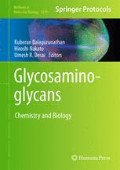Abstract
In situ hybridization provides information for understanding the localization of gene expression in various tissues. The relative expression levels of mRNAs in a single cell can be sensitively visualized by this technique. Furthermore, since in situ hybridization is a histological technique, tissue structure is maintained after fixation, and it is possible to accurately identify cell types. We have examined the expression of heparan sulfate sulfotransferases by in situ hybridization to better understand the functions of heparan sulfate in the development of mouse nervous system. This chapter describes methods of in situ hybridization analyses using cRNA probes labeled with nonradioactive nucleotides.
Access this chapter
Tax calculation will be finalised at checkout
Purchases are for personal use only
References
Bernfield M, Gotte M, Park PW, Reizes O, Fitzgerald ML, Lincecum J, Zako M (1999) Functions of cell surface heparan sulfate proteoglycans. Annu Rev Biochem 68:729–777
Kreuger J, Kjellén L (2012) Heparan sulfate biosynthesis: regulation and variability. J Histochem Cytochem 60:898–907
Lindahl U, Kjellén L (2013) Pathophysiology of heparan sulphate: many diseases, few drugs. J Intern Med 273:555–571
Mizumoto S, Sugahara K (2013) Glycosaminoglycans are functional ligands for receptor for advanced glycation end-products in tumors. FEBS J 280:2462–2470
Tiwari V, Maus E, Sigar IM, Ramsey KH, Shukla D (2012) Role of heparan sulfate in sexually transmitted infections. Glycobiology 22:1402–1412
Kinnunen T, Huang Z, Townsend J, Gatdula MM, Brown JR, Esko JD, Turnbull JE (2005) Heparan 2-O-sulfotransferase, hst-2, is essential for normal cell migration in Caenorhabditis elegans. Proc Natl Acad Sci U S A 102:1507–1512
Esko JD, Selleck SB (2002) Order out of chaos: assembly of ligand binding sites in heparan sulfate. Annu Rev Biochem 71:435–471
Yabe T, Hata T, He J, Maeda N (2005) Developmental and regional expression of heparan sulfate sulfotransferase genes in the mouse brain. Glycobiology 15:982–993
Cox KH, DeLeon DV, Angerer LM, Angerer RC (1984) Detection of mRNAs in sea urchin embryos by in situ hybridization using asymmetric RNA probes. Dev Biol 101:485–502
Wilcox JN, Gee CE, Roberts JL (1986) In situ cDNA:mRNA hybridization: development of a technique to measure mRNA levels in individual cells. Methods Enzymol 124:510–533
Shworak NW, Liu J, Fritze LM, Schwartz JJ, Zhang L, Logeart D, Rosenberg RD (1997) Molecular cloning and expression of mouse and human cDNAs encoding heparan sulfate d-glucosaminyl 3-O-sulfotransferase. J Biol Chem 272:28008–28019
Shworak NW, Liu J, Petros LM, Zhang L, Kobayashi M, Copeland NG, Jenkins NA, Rosenberg RD (1999) Multiple isoforms of heparan sulfate d-glucosaminyl 3-O-sulfotransferase. Isolation, characterization, and expression of human cDNAs and identification of distinct genomic loci. J Biol Chem 274:5170–5184
Shukla D, Liu J, Blaiklock P, Shworak NW, Bai X, Esko JD, Cohen GH, Eisenberg RJ, Rosenberg RD, Spear PG (1999) A novel role for 3-O-sulfated heparan sulfate in herpes simplex virus 1 entry. Cell 99:13–22
Lawrence R, Yabe T, Hajmohammadi S, Rhodes J, McNeely M, Liu J, Lamperti ED, Toselli PA, Lech M, Spear PG, Rosenberg RD, Shworak NW (2007) The principal neuronal gD-type 3-O-sulfotransferases and their products in central and peripheral nervous system tissues. Matrix Biol 26:442–455
Author information
Authors and Affiliations
Corresponding author
Editor information
Editors and Affiliations
Rights and permissions
Copyright information
© 2015 Springer Science+Business Media New York
About this protocol
Cite this protocol
Yabe, T., Maeda, N. (2015). Histochemical Analysis of Heparan Sulfate 3-O-Sulfotransferase Expression in Mouse Brain. In: Balagurunathan, K., Nakato, H., Desai, U. (eds) Glycosaminoglycans. Methods in Molecular Biology, vol 1229. Humana Press, New York, NY. https://doi.org/10.1007/978-1-4939-1714-3_29
Download citation
DOI: https://doi.org/10.1007/978-1-4939-1714-3_29
Published:
Publisher Name: Humana Press, New York, NY
Print ISBN: 978-1-4939-1713-6
Online ISBN: 978-1-4939-1714-3
eBook Packages: Springer Protocols

